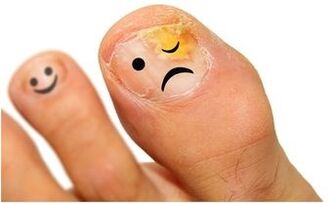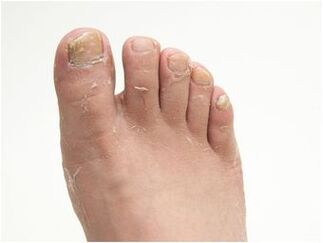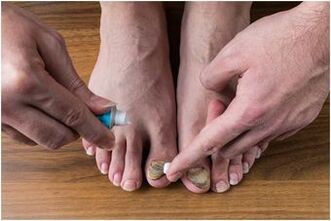
Epidermophytosis of the feet is a class of fungal diseases characterized by damage to the feet, interdigital areas and nails. It has a high prevalence, usually observed in people aged 30 years and older (rarely in children), prone to chronic diseases with alternating irritations and remissions.
Mycoses are infectious diseases caused by pathogenic or opportunistic fungi. Mushrooms are lower plants that have no chlorophyll and ready-made organic substances are needed for their vital activity - they get them by settling on the skin of humans and animals.
The causative agents of fungal infections are very persistent, which distinguishes them from other microorganisms. Fungal skin diseases are the most common in the world. Human contact with the fungus is constant - at home, at work, in the office, outdoors, in swimming pools, saunas, etc.
Where can you get mushrooms?
You can become infected with the fungus in many places of public use - baths, saunas, beaches, gyms (especially in showers), when you wear someone else's shoes.
The risks of infection increase many times if a person does not observe his hygiene.
Symptoms of fungus

The course and development of the disease is influenced by the physiological characteristics of the skin of the feet, increased sweating, disturbances in the endocrine system, foot injuries. Fungal causative agents may be able to "sleep" for a long time without giving themselves as symptoms. When disturbed in the body, they can be activated. Epidermophytosis of the feet is characterized by the presence of some forms of the disease, which can be complemented by damage to the nail plates.
You can determine the loss of fungus in the presence of several symptoms:
- the nail plate changes its natural color: the yellow or dark color is usually fixed, but the nails can also become white or completely black;
- keratosis of tissue under plaque: from the outside, it appears as if a strong growth has appeared under the nail;
- slab thickening and distortion;
- nail deformity: its elongation, lateral growth, growth on the skin;
- brittleness of the nail plate: fragmentation of its part is possible.
How the disease progresses
The first manifestations of the disease begin in the spaces between the toes, especially between 4 and 5, as there is the smallest distance between them. A slight itching begins and over time, a thick and slightly cracked cuticle strip appears on the fold of the finger.
After 2-3 days, a small crack has already formed, from which a serous fluid is released, which acts as an excellent tool for successful reproduction of fungi. The hard layer of the epidermis may fall off, revealing a dark pink area below. Progression of the disease leads to its spread throughout the toes and the adjacent side of the foot.
Through the damaged areas of the upper part of the skin, the fungus can penetrate into the deeper layers behind the epidermis. The disease is accompanied by an eczematous reaction. Fluid-filled blisters form on the skin, which itch a lot. Over time, they can combine and erode, leading to the appearance of weeping areas.
Reference! During the study of the skin affected by the fungus, it was found that the wet "naked" surface that appears under the blisters does not contain the pathogens themselves, but is only a consequence of their activity.
Without proper treatment in time, the fungus affects the entire surface of the foot and toes, sometimes reaching the area above the heel. There is an instability of the course - the disease then slows down, then intensifies again.
In the absence of therapy, the disease can drag on for many years. At the same time, there is a high risk of complications with the pathogen streptococcus: the fluid in the vesicles begins to irritate, the foci of inflammation spread beyond the initial boundaries, the foot swells strongly. It becomes difficult for a person to move due to leg pain. In addition, there may be complications in the form of lymph node problems.
The development of epidermophytosis usually occurs in the summer months. At this time, sweating increases, the fingers often get wet, and the added moisture in the interdigital areas creates favorable conditions for the introduction of the fungus and its active reproduction.
Mycosis usually appears on fingers 1 and 5, spreading on the free side. The nail gradually thickens, acquires a yellow tinge and an uneven sharp edge. Over time, pronounced subungual hyperkeratosis of varying degrees manifests itself.
Foot mold treatment
For successful therapy, a lot of attention should be paid to the treatment of lesions.

A person affected by the fungus should take foot baths daily with potassium permanganate. Crust removal, bubble drilling and removal of "fringe" along the boundaries of abrasive areas and irritated bubbles are required.
After the bath, it is necessary to apply medical dressing on the affected areas soaked in an aqueous solution of copper sulfate (0. 1%) and zinc (0. 4%) or a 1% solution of resorcinol. Once the weeping areas have begun to heal, fungicide-based alcoholic solutions are used. If necessary, the kit is supplemented with fungicide ointments.
Obtaining the desired result does not depend on the drugs used, but on the exact sequence of their use according to the current situation with inflammatory processes.
A major role is played by additional treatment after the end of the fight against lesions, because it helps prevent relapses. The skin of the feet is wiped with 2% salicylic alcohol or 1% thymol, and the use of 10% boron powder is required. To get rid of and prevent the appearance of fungus on shoes, you should wipe it from the inside with a formaldehyde solution, wrap it in a thick cloth for a few days and then dry it in fresh air. For socks, tights and socks, everything is simpler - they just need to be soaked in this solution for 10 minutes.
If there is a complication of pyococcus, then antibiotics are used. Be sure to respect bed rest.
prevention
To prevent the occurrence of fungal infections, the following preventive measures should be taken:
- owners of swimming pools, gyms, bathrooms should be more attentive to disinfection - to carry out a thorough treatment of the premises according to the set schedule;
- if there is a suspicion of a fungal infection, you should immediately consult a doctor to immediately terminate the disease;
- before going to bed, it is advisable to wash your feet with soap in cold water and wipe them thoroughly until they are dry;
- do not use someone else's shoes;
- change socks or stockings every day;
- when you visit swimming pools, baths, showers in gyms, you have your shoes on.
















